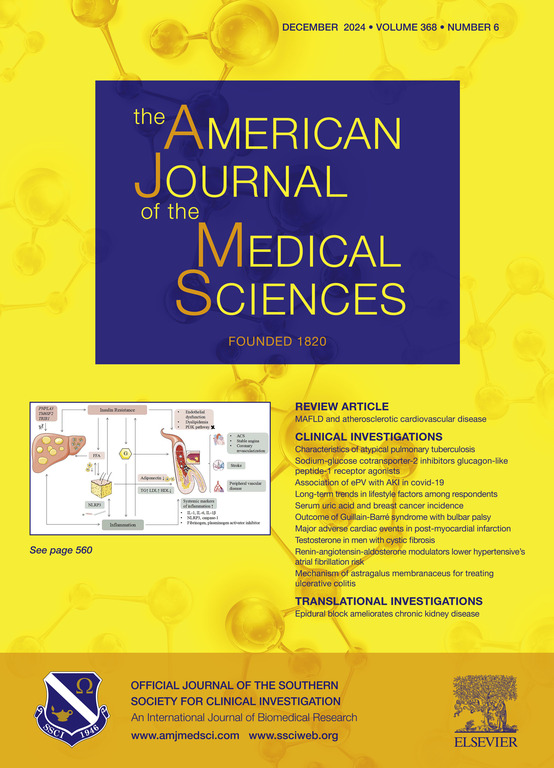鉴定和验证白血病抑制因子作为缺血性急性肾损伤的保护因子。
IF 2.3
4区 医学
Q2 MEDICINE, GENERAL & INTERNAL
引用次数: 0
摘要
背景:缺血再灌注损伤(IRI)是急性肾损伤(AKI)的常见病理生理机制。目前迫切需要对其潜在机制进行更全面的分析:我们使用 RNA 序列数据集 GSE153625 研究了 IRI-AKI 小鼠与假小鼠肾脏组织的差异表达基因(DEGs)。我们使用 cytohubba 插件提供的 10 种算法和四个外部数据集(GSE192532、GSE52004、GSE98622 和 GSE185383)筛选枢纽基因。建立了不同再灌注时间的 IRI-AKI 小鼠模型,以验证枢纽基因在肾脏中的表达。在缺氧/再氧合(H/R)条件下体外培养HK-2细胞,通过转染si-LIF或补充LIF蛋白来探索LIF基因的功能:结果:与假手术组相比,我们在IRI组共筛选了1,540个DEGs,发现LIF中枢基因可能在IRI-AKI中发挥潜在作用。LIF在IRI-AKI小鼠的肾脏组织以及在H/R条件下生长的HK-2细胞中明显上调。敲除 LIF 会加重 H/R 条件下的细胞凋亡和氧化应激(OS)损伤。给予 LIF 蛋白可缓解 si-LIF 的影响,减轻细胞凋亡和氧化应激损伤:这些研究结果表明,在 IRI-AKI 的早期阶段,LIF 基因在调节细胞凋亡和 OS 方面起着重要作用。因此,以LIF为靶点可能是治疗IRI-AKI的一种有前景的策略。本文章由计算机程序翻译,如有差异,请以英文原文为准。
Identification and validation of leukemia inhibitory factor as a protective factor in ischemic acute kidney injury
Background
Ischemia-reperfusion injury (IRI) is a common pathophysiological mechanism of acute kidney injury (AKI). There is an urgent need for a more comprehensive analysis of its underlying mechanisms.
Materials and methods
The RNA-sequencing dataset GSE153625 was used to examine differentially expressed genes (DEGs) of kidney tissues in IRI-AKI mice compared with sham mice. We used 10 algorithms provided by cytohubba plugin and four external datasets (GSE192532, GSE52004, GSE98622, and GSE185383) to screen for hub genes. The IRI-AKI mouse model with different reperfusion times was established to validate the expression of hub gene in the kidneys. HK-2 cells were cultured in vitro under hypoxia/reoxygenation (H/R) conditions, via transfection with si-LIF or supplementation with the LIF protein to explore the function of the LIF gene.
Results
We screened a total of 1,540 DEGs in the IRI group compared with the sham group and identified that the LIF hub gene may play potential roles in IRI-AKI. LIF was markedly upregulated in the kidney tissues of IRI-AKI mice, as well as in HK-2 cells grown under H/R conditions. The knockdown of LIF aggravated apoptosis and oxidative stress (OS) injury under H/R conditions. Administration of the LIF protein rescued the effects of si-LIF, alleviating cellular apoptosis and OS.
Conclusion
These findings indicate an important role of the LIF gene in term of regulating apoptosis and OS in the early phases of IRI-AKI. Targeting LIF may therefore represent a promising therapeutic strategy for IRI-AKI.
求助全文
通过发布文献求助,成功后即可免费获取论文全文。
去求助
来源期刊
CiteScore
4.40
自引率
0.00%
发文量
303
审稿时长
1.5 months
期刊介绍:
The American Journal of The Medical Sciences (AJMS), founded in 1820, is the 2nd oldest medical journal in the United States. The AJMS is the official journal of the Southern Society for Clinical Investigation (SSCI). The SSCI is dedicated to the advancement of medical research and the exchange of knowledge, information and ideas. Its members are committed to mentoring future generations of medical investigators and promoting careers in academic medicine. The AJMS publishes, on a monthly basis, peer-reviewed articles in the field of internal medicine and its subspecialties, which include:
Original clinical and basic science investigations
Review articles
Online Images in the Medical Sciences
Special Features Include:
Patient-Centered Focused Reviews
History of Medicine
The Science of Medical Education.

 求助内容:
求助内容: 应助结果提醒方式:
应助结果提醒方式:


